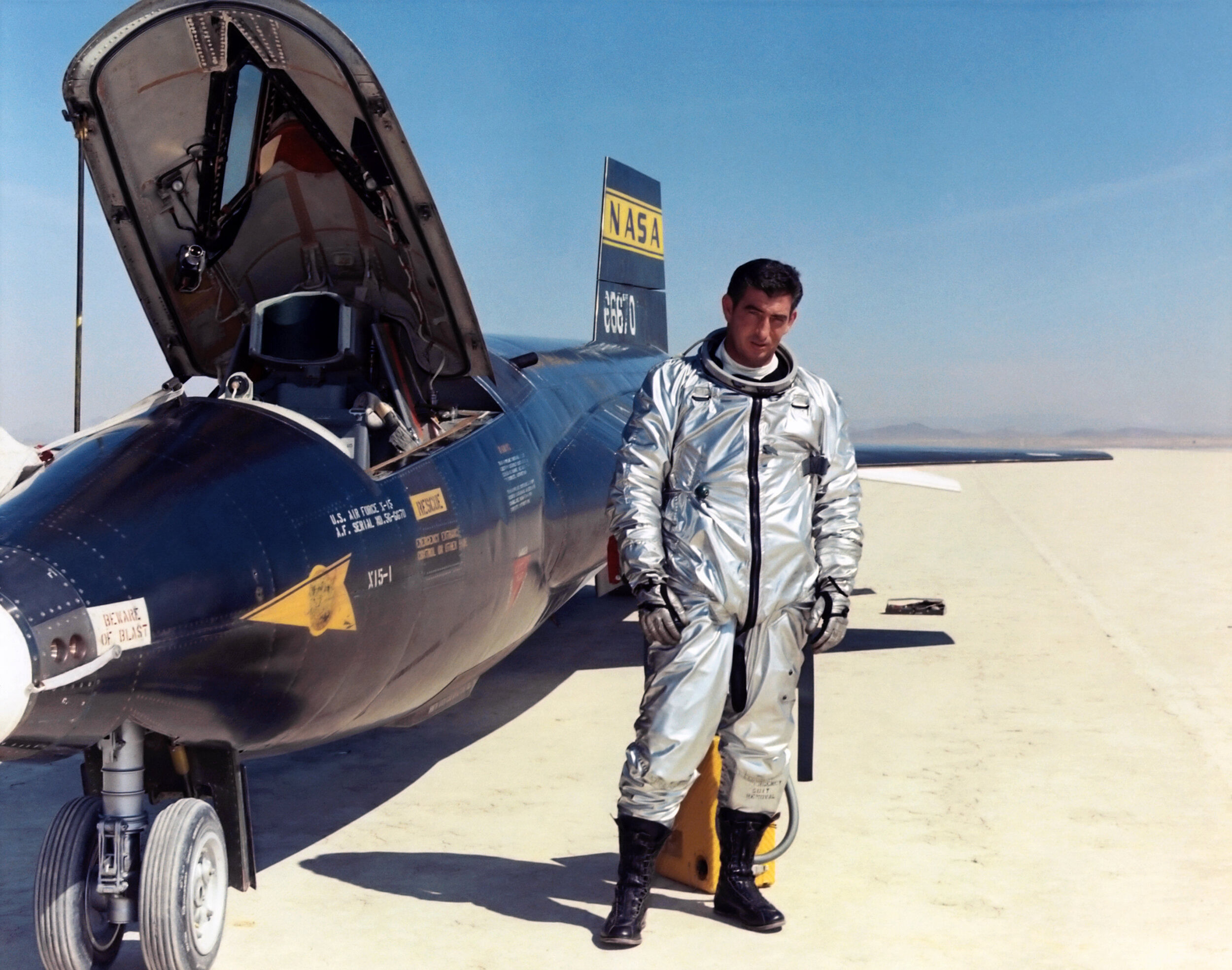Fly Me High!
Ian Mackay
Fly Me High A new podcast that explores the emotional and scientific desire of humankind to reach beyond the Kármán Line, a name given to describe the very edge of Outer Space,100 kilometres above the Earth. Technically, the Kármán Line is the height at which the atmosphere no longer provides aerodynamic lift to a vehicle in flight. It is also considered jurisdictional. Below the line, countries own their airspace, and above the line, anyone is free to venture. Jeff Bezos and Sir Richard Branson, in the summer of 2021 flew to the edge of space and argued about who had reached it. Bezos flew to 100 kilometres, the Kármán line, and Branson to 80 kilometres, the U.S. definition of the edge of space.
But in1963, test pilot Joe Walker flew a NASA rocket plane called the X-15 to 106 kilometres and then a month later flew to108 kilometres. The North American X-15 was an experimental high-speed rocket-powered research aircraft capable of reaching outer space and landing conventionally on an airstrip. Hundreds of flights took place between 1959 and 1967, making the X-15 rank supreme among rocket-powered aircraft. It became the world's first operational spaceplane in the early 1960s.
But the X-15 was not without risk. Test pilot Michael J. Adams flew the X-15 to 81 kilometres in 1967 and tragically lost control at peak altitude. In episode 1 of Fly Me High, we reenact the last dialogue of Mike Adams with Pete Knight, a fellow pilot, on the ground at Edwards Airbase as he reaches the apogee of his flight.
This podcast is different in that it reimagines the experiences of space and its pioneers through audio reenactments fusing historical records with audio dramatization. Imagine old radio. Speech synthesis, radio hisses, noise, and background hum come and go to fill out the audio experience, along with a little sixties rock’n’roll. Hope you enjoy it. So, let’s go!
PODCAST
VIDEO DRAMATIZATION
TRANSCRIPT
Adams: “I lost my pitch and roll dampers.”
Pete: “OK Mike. Let's try and get them on.”
Adams: “They reset.”
Pete: “Did they reset?”
Adams: “Yep.”
Pete: “And, I'll give you a peak altitude, Mike.”
Pete: “Have you coming over the top. You're looking real good. Right on the heading Mike.”
Pete: “Over the top at about 261Mike.” (261,000 feet)
Pete: ”Check your attitudes.”
Pete: “You're a little bit hot, but your heading is going in the right direction Mike. Real good.”
Pete: “Check your attitudes.”
Pete: “How do you read Mike?”
Pete: “OK, let's check your dampers Mike.”
Adams: “They're still on.”
Pete: “OK.”
Pete: “A little bit high, Mike, but real good shape.”
Pete: “And, we got you coming down hill now.”
Pete: “Are your dampers still on?”
Chase 1: “Dampers still on Mike?” (Squelch break)
Adams: “Yeah, and it seems squirrely.”
Pete: “OK, have you coming back through 230. Ball nose, Mike.”
Pete: “Let's watch your alpha, Mike.”
Pete: “Let's not keep it as high as normal with this damper problem.”
Pete: “Have you at 210. alpha, beta and check your alpha, Mike.”
Adams: “I'm in a spin, Pete.”
Pete: “Let's get your experiment in and the camera on.”
Pete: “Let's watch your theta, Mike.”
Adams: “I'm in a spin.”
Pete: “Say again.”
Adams: ”I'm in a spin.”
Pete: “Say again”.
Pete: “OK, Mike, you're coming through about 135 now. Let's get it straightened out.” (2 squelch breaks)
Pete: “OK, you got theta zero now.”
Pete: “Get some angle of attack up.”
Pete: “Coming up to 80,000, Mike.
Pete: “Let's get some alpha on it.”
Pete: “Get some "g" on it, Mike.”
Pete: “Let's get some "g" on it.”
Pete: “We got it now, let's keep it there.”
Pete: “Coming around.”
Pete: “OK, let's keep it up, Mike. Keep pulling it up”.
Pete: “Do you read, Mike? Let's keep pulling it up, Mike.”
Pete: “OK, 130 let's head down that way.”
Pete: “He was abeam Cuddeback, 130 - 358.”
Pete: “Chase 4, do you have anything on him?”
Chase 4: “Negative”.
Pete: “OK, Mike, do you read?”
Chase 4: “Pete, I got dust on the lake down there.”
Pete: “What lake?”
Mike Adams X15 Flight
Tragedy at the Edge of Space
Early life and military experience
Adams was born May 5, 1930, in Sacramento, California. He graduated from Sacramento Junior College. He enlisted in the United States Air Force in 1950, and earned his pilot wings and commission in 1952 at Webb Air Force Base, Texas. He served as a fighter-bomber pilot during the Korean War, where he flew 49 combat missions. This was followed by 30 months with the 613th Fighter-Bomber Squadron at England Air Force Base, Louisiana, and six months rotational duty at Chaumont Air Base in France.[2]
Education and flight experience
In 1958, Adams received a Bachelor of Science degree in Aeronautical Engineering from the University of Oklahoma and, after 18 months of astronautics study at Massachusetts Institute of Technology, was selected in 1962 for the U.S. Air Force Test Pilot School at Edwards Air Force Base, California. Here, he won the A.B. Honts Trophy as the best scholar and pilot in his class. Adams subsequently attended the Aerospace Research Pilot School (ARPS), graduating with honors in December 1963. He was one of four Edwards aerospace research pilots to participate in a five-month series of NASA Moon landing practice tests at the Martin Company in Baltimore, Maryland. In November 1965 he was selected to be an astronaut in the United States Air Force Manned Orbiting Laboratory program. In July 1966, Major Adams came to the North American X-15 program, a joint USAF/NASA project. He made his first X-15 flight on October 6, 1966.[2]
Death
Adams' seventh X-15 flight, Flight 3-65-97, took place on November 15, 1967.[3][4] He reached a peak altitude of 266,000 feet (81 km); the nose of the aircraft was off heading by 15 degrees to the right. While descending, at 230,000 feet (70 km) the aircraft encountered rapidly increasing aerodynamic pressure which impinged on the airframe, causing the X-15 to enter a violent Mach 5 spin. As the X-15 neared 65,000 feet (20 km), it was diving at Mach 3.93 and experiencing more than 15 g vertically (positive and negative), and 8 g laterally, which inevitably exceeded the design limits of the aircraft. The aircraft broke up 10 minutes and 35 seconds after launch, killing Adams. The United States Air Force posthumously awarded him Astronaut Wings for his last flight.
An excerpt from NASA's biography page on Mike Adams discusses findings from the crash investigation:
Ground parties scoured the countryside looking for wreckage; critical to the investigation was the film from the cockpit camera. The weekend after the accident, an unofficial FRC search party found the camera; disappointingly, the film cartridge was nowhere in sight. Engineers theorized that the film cassette, being lighter than the camera, might be further away, blown north by winds at altitude. FRC engineer Victor Horton organized a search and on 29 November, during the first pass over the area, Willard E. Dives found the cassette. Most puzzling was Adams' complete lack of awareness of major heading deviations in spite of accurately functioning cockpit instrumentation. The accident board concluded that he had allowed the aircraft to deviate as the result of a combination of distraction, misinterpretation of his instrumentation display, and possible vertigo. The electrical disturbance early in the flight degraded the overall effectiveness of the aircraft's control system and further added to pilot workload. The MH-96 adaptive control system then caused the airplane to break up during reentry.[2]
His remains were buried at the Mulhearn Memorial Park Cemetery, Monroe, Ouachita Parish, Louisiana.[5]
ARTIST
Ian Mackay is a Canadian artist living in Toronto where he maintains his studio. He completed his AOCA at Ontario College of Art in 1980 with studies in Photo-Electric Arts. At OCA Ian co-founded the punk rock band The Diodes and the musical performance space "The Crash n Burn" at the Centre for Experimental Art and Communications. Upon graduation, Ian balanced career and vocation, including positions at Delrina Corporation, Symantec Corporation and IBM Platform Computing where he focussed on software architecture and user-centred design. In 2009 he completed a BFA at OCAD in Curatorial Studies and Integrated Media. Since 2009 Ian has concentrated exclusively on his painting and audio practices and his work can be found in numerous private collections.
This project was made possible with the generous support of the Ontario Trillium Foundation.






